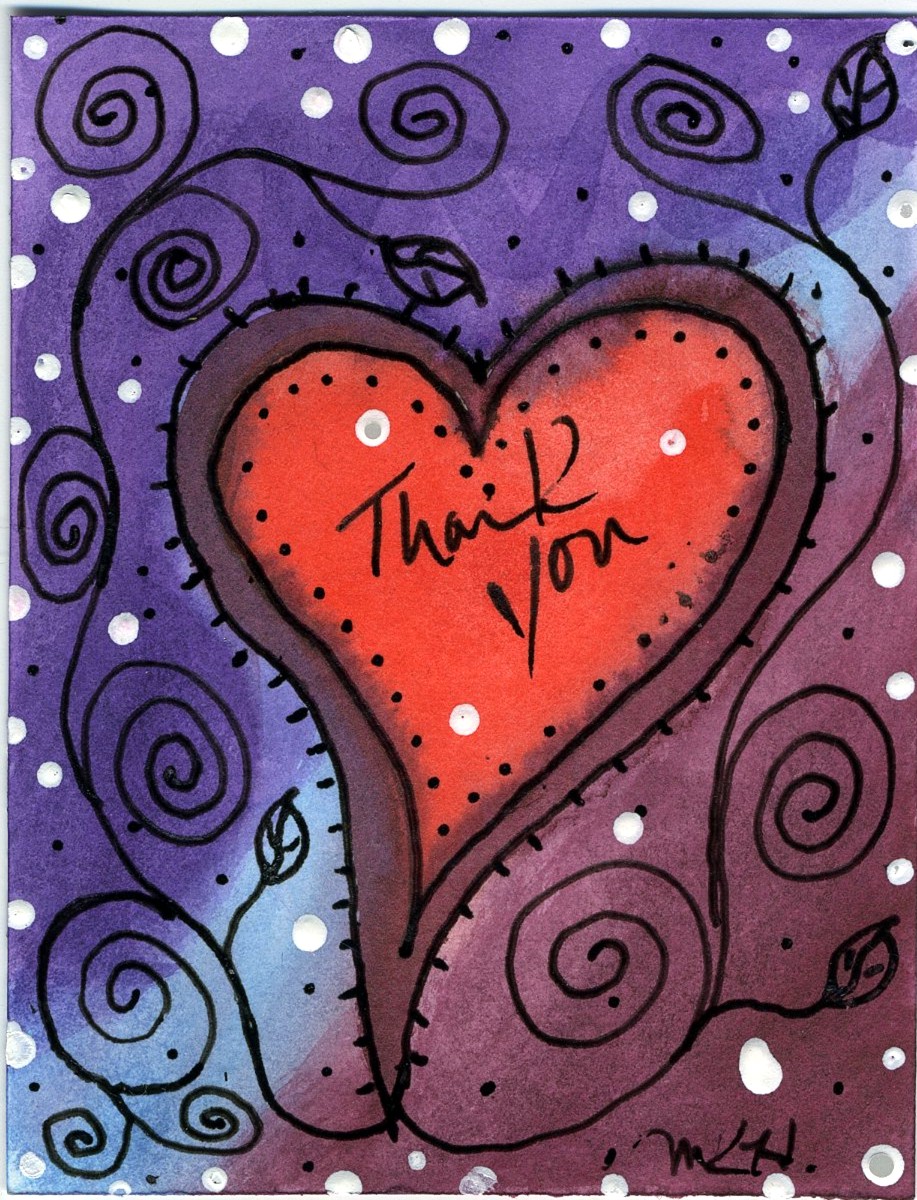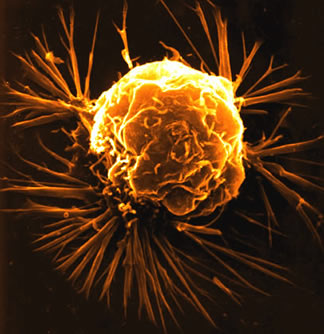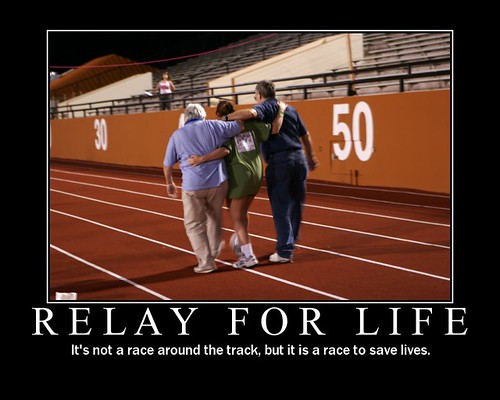Monday, April 28, 2008
Saturday, April 26, 2008
THANK YOU!!!!!!!!!!!!!!

I hope you came away with something more than a great time with friends and a stomach full of great food! That is aways a given at Relay but......
I hope you came away with a better understanding of cancer and the hope that one day you or your kids will never have to hear the words "you have cancer...."
That hope for a cure is why we Relay! That is why all the fun, food, and the stayin up all night happens!
Each one of those white paper bags you saw last night as you walked around the track represented one person who had fought the battle with cancer (some won... some did not) ....
I have lost a grandmother to colon cancer (my Mamalone died when I was 5); my other grandmother won her battle against colon cancer as did my Dad.... I have lost many cousins and friends to this dreaded disease.... and I want it to end.... So lets all keep Relaying EVERYDAY by doing so we keep the HOPE with us everyday!
LETS KICK CANCERS BUTT!
http://www.relayforlife.org/
http://www.cancer.org/
http://www.komen.org/
http://www.jimmyv.org/
http://www.livestrong.org/
http://www.leukemia.org/
Wednesday, April 23, 2008
Cancer Did You Knows!

New cases: 1,437,180 (does not include nonmelanoma skin cancers)
Deaths: 565,650
KEY POINTS
1)The survival rate for many types of cancer has improved in recent years; however, cancer is still the second leading cause of death in the United States
2)Cancer occurs when cells continue to grow and divide and do not die when they should. Cancer cells can damage or destroy nearby tissues and can metastasize (spread) to distant parts of the body through the bloodstream or lymphatic system
3)Cancer is the result of changes in the genes that control normal cell growth and death. These changes may be inherited, or may result from environmental or lifestyle factors
4)People can reduce their risk of cancer by adopting a healthy lifestyle. Also, screening exams can detect some precancerous conditions and early-stage cancer
5)Cancer can cause a variety of symptoms
6)Cancer can be treated with surgery, radiation therapy, chemotherapy, hormones, and/or biological therapy
Cancer is the second leading cause of death in this country. However, improvements in cancer detection, diagnosis, and treatment have increased the survival rate for many types of cancer. About 64 percent of all people diagnosed with cancer will be alive 5 years after diagnosis (1).
What is cancer?
Cancer is a group of many related diseases that begin in cells, the body’s basic building blocks. To understand cancer, it is helpful to know what happens when normal cells become cancerous.
The body is made up of many types of cells. Normally, cells grow and divide to produce more cells as they are needed to keep the body healthy. Sometimes, this orderly process goes wrong. New cells form when the body does not need them, and old cells do not die when they should. The extra cells form a mass of tissue called a growth or tumor. Not all tumors are cancerous; tumors can be benign or malignant.
Although there is no guaranteed way to prevent cancer, people can reduce their risk (chance) of developing cancer by:
not using tobacco products
choosing foods with less fat and eating more vegetables, fruits, and whole grains
exercising regularly and maintaining a lean weight
avoiding the harmful rays of the sun, using sunscreen, and wearing clothing that protects the skin
talking with a doctor about the possible benefits of drugs proven to reduce the risk of certain cancers
Although many risk factors can be avoided, some, such as inherited conditions, are unavoidable. Still, it is helpful to be aware of them. It is also important to keep in mind that not everyone with a particular risk factor for cancer actually gets the disease; in fact, most do not. People who have an increased likelihood of developing cancer can help protect themselves by avoiding risk factors (see Question 2) whenever possible and by getting regular checkups so that, if cancer develops, it is likely to be found and treated early. Treatment is often more effective when cancer is detected early. Screening exams, such as sigmoidoscopy or the fecal occult blood test, mammography, and the Pap test, can detect precancerous conditions (which can be treated before they turn into cancer) and early-stage cancer.
Cancer can cause a variety of symptoms.
new thickening or lump in the breast or any other part of the body
new mole or an obvious change in the appearance of an existing wart or mole
a sore that does not heal
nagging cough or hoarseness
changes in bowel or bladder habits
persistent indigestion or difficulty swallowing
unexplained changes in weight
unusual bleeding or discharge
When these or other symptoms occur, they are not always caused by cancer. They can be caused by infections, benign tumors, or other problems. It is important to see a doctor about any of these symptoms or about other physical changes. Only a doctor can make a diagnosis. A person with these or other symptoms should not wait to feel pain because early cancer usually does not cause pain.
If symptoms occur, the doctor may perform a physical examination, order blood work and other tests, and/or recommend a biopsy. In most cases, a biopsy is the only way to know for certain whether cancer is present. During a biopsy, the doctor removes a sample of tissue from the abnormal area. A pathologist studies the tissue under a microscope to identify cancer cells
Cancer treatment can include surgery, radiation therapy, chemotherapy, hormone therapy, and biological therapy. The doctor may use one method or a combination of methods, depending on the type and location of the cancer, whether the disease has spread, the patient’s age and general health, and other factors. Because treatment for cancer can also damage healthy cells and tissues, it often causes side effects. Some patients may worry that the side effects of treatment are worse than the disease. However, patients and doctors generally discuss the treatment options, weighing the likely benefits of killing cancer cells and the risks of possible side effects. Doctors can suggest ways to reduce or eliminate problems that may occur during and after treatment.
Having cancer does not always mean having pain. Whether a patient has pain may depend on the type of cancer, the extent of the disease, and the patient’s tolerance for pain. Most pain occurs when the cancer grows and presses against bones, organs, or nerves. Pain may also be a side effect of treatment. However, pain can generally be relieved or reduced with prescription medicines or over-the-counter drugs recommended by the doctor. Other ways to reduce pain, such as relaxation exercises, may also be useful. Pain should not be accepted as an unavoidable part of having cancer. It is important for patients to talk about pain so steps can be taken to help relieve it. In addition, changing the dose or type of medication can usually help if the patient has troublesome side effects.
Relay For Life!

WHEN: Friday APRIL 25
WHAT: RELAY FOR LIFE at Warren Central High School.
TIME: The Scouts will need to be there at 3:45pm.
WHY YOU NEED TO COME: We will have to set up the dining fly.
UNIFORM COLOR CHANGE!!!!!!!! I know at the meeting Monday night they said to wear your green class B shirt, but Ms Tracye asked that you wear your PURPLE shirt. Purple represents those who have cancer and those who may have survived. SO PLEASE WEAR PURPLE SHIRT!!!!!
Relay For Life supports the American Cancer Society's Constant Mission To Find a CURE For Cancer!!!! It also supports their constant support of patients and their families.... All monies raised in Warren County stay in Warren County to help those who fight the good fight against CANCER! There will be fun, fellowship, and great foods!!!!! Please come out and show your support it is for a GOOD CAUSE.....and you will have a lot of fun PROMISE!!!!!!!!!!!
But remember a Scout is REVERENT so please during the LUMINARY CEREMONY and rememberance part of the night PLEASE be quiet and listen! It means so much to all of us who have lost a loved one to the disease and who have lived through the battle with a loved one and it is especially moving to all those their who are fighting the disease and who have fought and survived! PLEASE BE REVERENT ---- THANK YOU!
SEE YA THERE!!!!!
MS SHERR
Monday, April 07, 2008
University Of Scouting

University Of Scouting 2008
Saturday April 26, 2008
Hinds Community College --- Pearl Campus
$25.00 by April 11 / $30 after April 11
All Classes are limited to 12 participants so sign up early!
For a list of classes email Ms Tracye at dogsrule1@bellsouth.net
The University of Scouting is a multilevel supplemental training designed for Leaders of Cub Scouts, Boy Scouts, And Venturers, as well as Den Chiefs, Committee Members, Commissioners, and anyone interested in helping and learning the Scout way.
The class schedule is set up so you can take up to six classes of your choice--- take what YOU want or need. Come learn and share the fun and adventure that is Scouting!
Share your adventures: Bring a poster or displays of activities your unit has done or enjoyed. We can all learn from our shared experiences.
The Trading Post will be back! They will have on hand materials relevant to courses being offered. It will also allow you a chance to browse and purchase available resources from The Scout Shop.
Den Chief Training: If you have Scouts acting as Den Chiefs or interested in being a Den Chief bring them with you.... They can and will benefit from the excellent training offered at the University.
Check In and Registration begins at 7:30 am
Opening Ceremonies 8:30 am
You will receive your degree certificate during closing ceremonies at 4:00 pm
Preregistered attendees receive:
Lunch
Specially Designed Patch
and A Binder to keep up with course materials.
Classes are from 9:00 am until 3:50 pm
Lunch is from 11:50 am - 1:00 pm
Degrees offered:
Associate's Degree --- complete any 6 classes
Bachelor's Degree --- Have previously completed Leader Specific Training for your position in the program area you are seeking a degree. Youth Protection Training (within the last two years/can be one of the 6 classes taken at the University) four courses from your college, adn two more of your choice for a total of 6 classes
Master's Degree --- Have previously earned a Bachelor's Degree in your program area, complete 6 additional classes, including four more from your college
University Staff --- Scouters who teach a course at the University may count the course as part of the 6 classes necessary for a degree.


